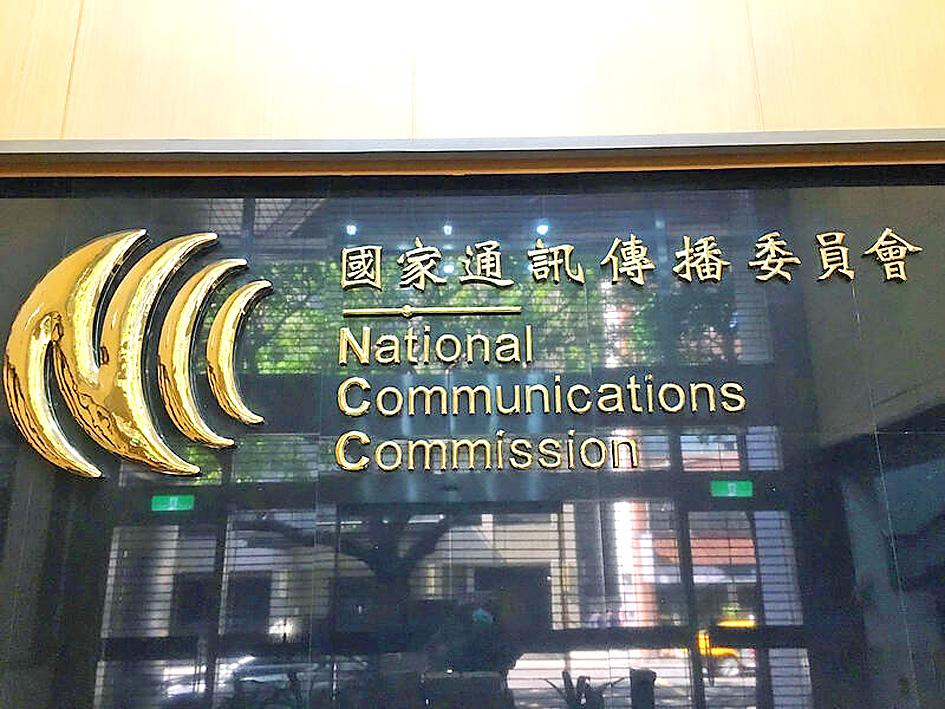Six cable television channels have been collectively fined a total of NT$6.2 million (US$193,944) for contravening the Satellite Broadcasting Act (衛星廣播電視法) by turning programs into infomercials for specific healthcare products, the National Communications Commission said yesterday.
GTV Channel One (八大第一台), Azio TV (東風衛視台), CTi Entertainment (中天綜合台), EBC Drama (東森戲劇台), EBC Variety (東森綜合台) and Jet Entertainment helped promote products in a one-hour program titled Asia Healthy King (亞洲健康王), the commission said, adding that the episodes scrutinized by the commission were aired on Oct. 27, Nov. 16 and Nov. 25 last year, as well as on Jan. 3 and March 14 this year.
The Oct. 27 episode, which was simultaneously broadcast on GTV Channel One, Azio TV, CTi Entertainment, EBC Drama and EBC Variety, invited guests to promote specific healthcare products, who explained in detail the effectiveness and ingredients of the products and how they should be used, the commission said.

Photo: Yang Mien-chieh, Taipei Times
The host of the program kept encouraging viewers to call in for more information about the products and purchase them, which blurred the line between programs and commercials, it said.
The five channels were fined NT$600,000, NT$800,000, NT$400,000, NT$800,000 and NT$600,000 respectively, the commission said.
In another episode that aired on Nov. 16 on Jet Entertainment and on Nov. 25 on Azio TV, the program promoted the same products by reminding audiences to call in to get free samples or have samples delivered to their homes free of charge. They were fined NT$600,000 and NT$800,000 respectively, it said.
Azio TV was fined NT$1 million for promoting the same products in the episode on Jan. 3, while GTV was fined NT$600,000 for committing the same offense in the episode on March 14, the commission said.
The fines were set mainly based on the record of punishment that each channel has accumulated over the past two years, it said.
Azio TV received heavier fines — NT$2.6 million in total — because it has committed the same offense eight times in the past two years, more than other channels, the commission said, adding that the channel had just completed a midterm evaluation last year.
“We will offer the channel ‘administrative guidance,’ in which the channel would be asked to address the issue, or it would be a problem when the channel applies for license renewal in 2025,” Department of Broadcasting and Content senior specialist Chen Chin-shuan (陳金霜) said.
Azio TV is owned by Taiwanese media tycoon Lien Tai-shen (練台生), who also owns the ERA TV and Next TV networks.
The commission in 2010 rejected a license renewal filed by ERA TV’s variety channel after the channel repeatedly contravened Article 30 of the act requiring a clear separation of programming and commercials, accumulating fines topping NT$16.75 million over six years.
Meanwhile, subscribers of Taiwan Mobile and Far Eastone Telecommunications would from Sept. 28 hear a warning that it might be a scam whenever they receive calls from numbers beginning with (+886 9), NCC Vice Chairman and spokesperson Wong Po-tsung (翁伯宗).
Starting tomorrow, subscribers to Chunghwa Telecom’s landline service are to receive a seven-second potential scam warning when they receive an international call, while its mobile phone service subscribers would hear the same warning when they receive a call from numbers beginning with (+886 9), Wong said.
“As incentives, we have decided to provide a subsidy of NT$103.5 million to telecoms to build networks that can intercept potential scam calls and warn phone users. Chunghwa Telecom would receive a majority of the subsidy as it offers landline and mobile phone services,” Wong said.

An essay competition jointly organized by a local writing society and a publisher affiliated with the Chinese Communist Party (CCP) might have contravened the Act Governing Relations Between the People of the Taiwan Area and the Mainland Area (臺灣地區與大陸地區人民關係條例), the Mainland Affairs Council (MAC) said on Thursday. “In this case, the partner organization is clearly an agency under the CCP’s Fujian Provincial Committee,” MAC Deputy Minister and spokesperson Liang Wen-chieh (梁文傑) said at a news briefing in Taipei. “It also involves bringing Taiwanese students to China with all-expenses-paid arrangements to attend award ceremonies and camps,” Liang said. Those two “characteristics” are typically sufficient

A magnitude 5.9 earthquake that struck about 33km off the coast of Hualien City was the "main shock" in a series of quakes in the area, with aftershocks expected over the next three days, the Central Weather Administration (CWA) said yesterday. Prior to the magnitude 5.9 quake shaking most of Taiwan at 6:53pm yesterday, six other earthquakes stronger than a magnitude of 4, starting with a magnitude 5.5 quake at 6:09pm, occurred in the area. CWA Seismological Center Director Wu Chien-fu (吳健富) confirmed that the quakes were all part of the same series and that the magnitude 5.5 temblor was

The Central Weather Administration has issued a heat alert for southeastern Taiwan, warning of temperatures as high as 36°C today, while alerting some coastal areas of strong winds later in the day. Kaohsiung’s Neimen District (內門) and Pingtung County’s Neipu Township (內埔) are under an orange heat alert, which warns of temperatures as high as 36°C for three consecutive days, the CWA said, citing southwest winds. The heat would also extend to Tainan’s Nansi (楠西) and Yujing (玉井) districts, as well as Pingtung’s Gaoshu (高樹), Yanpu (鹽埔) and Majia (瑪家) townships, it said, forecasting highs of up to 36°C in those areas

The brilliant blue waters, thick foliage and bucolic atmosphere on this seemingly idyllic archipelago deep in the Pacific Ocean belie the key role it now plays in a titanic geopolitical struggle. Palau is again on the front line as China, and the US and its allies prepare their forces in an intensifying contest for control over the Asia-Pacific region. The democratic nation of just 17,000 people hosts US-controlled airstrips and soon-to-be-completed radar installations that the US military describes as “critical” to monitoring vast swathes of water and airspace. It is also a key piece of the second island chain, a string of